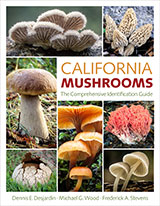The North American Species of Pholiota
7. Pholiota curvipes (Fr.) Quel., Champ Jura et Vosges p. 230. 1872.
Agaricus curvipes Fries, Epicr. Syst. Myc. p. 168. 1838.
Dryophila curvipes (Fr.) Quélet, Enchir. Fung. p. 69. 1886.
Illustrations: Text figs. 3-4; pl. 4a.
Pileus (1) 2-5 (6) cm. broad, obtuse to convex, the margin incurved, becoming broadly convex or nearly plane, at times with a low obtuse umbo; surface dry, opaque, fibrillose, the epicutis becoming broken up into small appressed to slightly recurved squamules, squamules around the disc often small and inconspicuous, at times the extreme margin lacerate-fibrillose or appendiculate from the remains of the thin veil; color brilliant yellow to ferruginous yellow or finally ferruginous ("Mars yellow" to "Cadmium-yellow" or "ochraceous-orange"). Context thin, pliant, yellow. Odor and taste mild.
Lamellae moderately close to subdistant, broad, adnate, whitish in small buttons but soon yellow and finally more or less cinnamon from the spores, edges even but in age crenulate.
Stipe 2-5 (9) cm long, 2-5 (7) mm thick, curved or ascending, more or less concolorous with the pileus, equal, tubular, apex clear yellow, floccose fibrillose, becoming more or less rusty brown from handling. Veil pale yellow, fibrillose, forming an evanescent fibrillose zone where it breaks. Spores 6-8.5 (9) x 3.5-4.5 (5) µ, rusty brown in KOH, smooth, in face view elliptic to ovate, in profile somewhat bean-shaped, wall scarcely thickened, no germ pore visible.
Basidia 20-26 x 4.5-6 µ, 4-spored, yellow in KOH or some with rusty brown content, yellow pigment diffusing in the mount from the hymenium. Pleurocystidia none. Cheilocystidia 24-42 (60) x 3-9 µ, cylindric to narrowly clavate to more or less capitate and flexuous down to the base, often in tufts, yellowish hyaline or with ochraceous to pale tawny content, thin-walled, smooth. Caulocystidia 28-60 x 4-9 µ, similar in shape to cheilocystidia but often more highly colored.
Gill trama parallel to somewhat interwoven, hyphal cells enlarged in age, walls thin and yellowish in KOH, hyphae narrower near subhymenium; subhymenium not distinctive. Pileus cuticle of fascicles of appressed hyphae with cinnamon to reddish cinnamon walls smooth to slightly incrusted as revived in KOH, cells inflated to 20 µ at times, end-cells usually merely narrowed to an obtuse to subacute apex. Clamp connections present. All tissues inamyloid.
Habit, Habitat, and Distribution: On logs, stumps and sawdust of hardwoods, especially aspen, rarely on conifer logs such as Larix: Maine, New York, Michigan and Missouri, in the United States, and Ontario in Canada.
Observations: This species, P. multifolia and P. subsulphurea intergrade. However, the characters given in the key will serve to distinguish most collections. Although the hyphae of the pileus cuticle are mostly of uninflated cells, some inflated cells do occur and this is evidence, in our estimation, of the evolutionary tendency toward the P. erinaceella type. Singer believed that the similarities between these fungi constituted a parallelism and were not an indication of true relationship. We hold the opposite view. We have followed Singer in recognizing both P. tuberculosa and P. curvipes. Some authors regard them as synonyms.
Material Examined: MAINE: Bigelow (Tenn. 23833). MICHIGAN: Harding 131, 139, 151, 161, 162, 186, 187, 232, 386, 393, 422; Langdon 11-8-93; Kauffman 6-6-10; Shaffer 612, 1753, 2167, (MICH); Smith 33-967, 33-1104, 9547, 9558, 15060, 18855, 21468, 21559, 25606, 25712, 25753, 25837, 33822, 33894, 36310, 36350, 36692, 37587, 38399, 38849, 39687, 66971, 68792; Thiers 688, 2665, 2729, 2746, 3059 (MICH): TENNESSEE Hesler 14195 (TENN): CANADA (ONTARIO): Beardslee 9-3-21.

